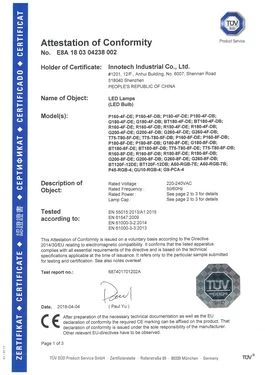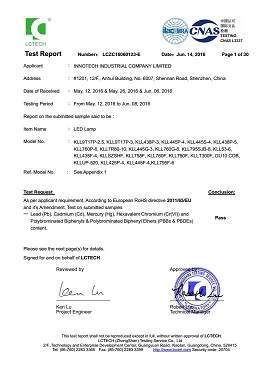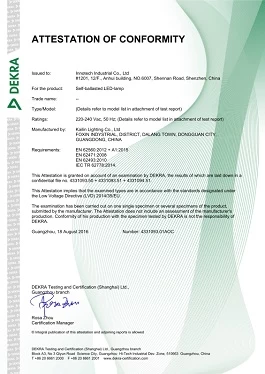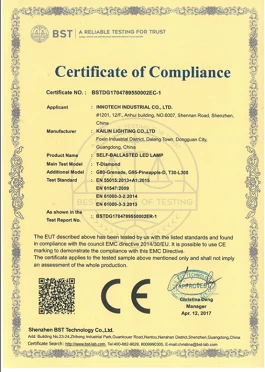ENERGY STAR bulb V2.1 approved specifications will take effect

filament LED bulbs supplier china
The newly released ENERGY STAR Accreditation Specification version 2.1 and the current 2.0 version have the following major changes: First, the V2.1 version removes unnecessary definitions and adds a definition of the filament lamp, and is specified in the sampling test. If any of the samples in the same series fail the test, all products in the series will be identified as failed for the sampling test. The second is to clearly specify the specific differences in the same series of models need to increase the size measurement. Third, V2.1 clearly stipulates that the replacement power cannot be the power of an incandescent or halogen lamp that does not exist on the market. At the same time, the room temperature aging test temperature condition of 25 °C ±1 °C in version 2.0 was deleted. For the new room temperature aging test temperature, please refer to the corresponding aging test standard. The fourth is to modify the declared lifetime of all solid-state lighting to a minimum of 15000H. The standby power test, strobo test, noise test and other chapters have also been updated and adjusted compared with the V2.0 version.

china LED Filament light Bulbs manufacturer
Energy Star is a voluntary energy conservation program led by the US Environmental Protection Agency. There are currently seven countries and regions in the world participating in the US Environmental Protection Agency's Energy Star program, namely the United States, Canada, Japan, Taiwan, Australia, New Zealand, and the European Union. In these countries and regions, the ENERGY STAR logo has a very high market acceptance, and the market share of ENERGY STAR in the US market is as high as 85%. The program currently includes energy efficiency product certification, energy efficient home projects, energy efficiency new home programs, and energy efficiency planning for buildings and plants. Among them, energy efficiency product certification is divided into electronic products, and gradually extended to home appliances, lighting equipment, and construction products. At present, it covers nearly eight kinds of products, including electronics, home appliances, lamps and fans, office equipment, refrigeration and heating equipment, water heaters, and construction products.

shenzhen LED Filament light Bulbs manufacturer
Lighting product certification is an important part of the ENERGY STAR program, mainly for solid-state lighting products for general lighting, including decorative products with significant lighting functions, both for commercial applications and residential products. The V1.1 standard came into effect on February 1, 2009. In January 2017, the standard V2.0 has replaced the original V1.1 standard. In June, the EPA released the ENERGY STAR bulb V2.1 standard. The new standard will be On October 1, 2017, the V2.0 standard was officially replaced. This update requires that products that have been certified to the V2.0 standard do not need to be recertified.
Lighting products have always occupied an important position in China's export products. Taking Ningbo area as an example, from January to May 2017, lamps and lighting fixtures exported a total of 9.41 billion yuan, a year-on-year increase of 2.1%. Among them, the United States is also the main trading partner of China's lighting products export. The release of the US Energy Star bulb V2.1 standard will have a greater impact on the export of lighting products within the scope. In view of this, the inspection and quarantine department reminds relevant export enterprises: First, we must keep abreast of the specific requirements of the US Energy Star on lighting product certification specifications, especially to strengthen the study of standard update information, pay more attention to the latest trends of the US official website, and be good at Use the information platform of the domestic government and various institutions to keep abreast of relevant regional and national information, and communicate with foreign customers in a timely manner, from product design, raw material procurement, assembly production, packaging information, etc., to ensure that products meet the new ENERGY STAR approval. Regulations. Second, we must evaluate the products in advance according to the requirements of the regulations. We must be cautious in the selection of raw and auxiliary materials suppliers. New products and new raw materials must be commissioned by specialized testing organizations to conduct special tests on the energy efficiency levels of the products to avoid unnecessary follow-up disputes and losses. The third is to seriously study the products and quality problems of all kinds of notifications and recalls in foreign countries. In other words, we must focus on the key links of energy efficiency requirements, and turn blindly pursuing low-cost benefits into focusing on the products themselves and improving the control of energy efficiency of products.

 +
+



















